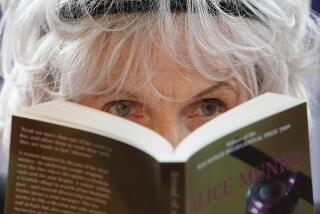The evergreen ‘Anne of Green Gables’
- Share via
The planks that made up her bedroom wall did not fit together properly, so when she would wake up on winter mornings in an old house on Prince Edward Island, Canada, often there were snowdrifts on the floor. To keep warm while she wrote her stories, she had to curl up her legs and sit on her feet. Her secondhand typewriter lacked a “w” key.
Still she wrote. (Or “rote,” as it would have appeared in her typewritten version.) Obstacles, hardships, setbacks, impediments -- they counted for nothing. Lucy Maud Montgomery, who roomed with relatives because her mother had died when she was an infant and her father left to seek his fortune elsewhere, was a small woman with a staggeringly strong will. Her imagination was a driving force that would not be denied.
When Montgomery finished her first novel, she mailed it to publisher after publisher. The rejection slips piled up like the snowdrifts in that bedroom.
And then, after more than two dozen publishers had said no, one finally said yes, and the young orphan known as Anne Shirley -- don’t forget the “e” at the end of “Anne,” or she’ll let you know about it -- was born into the world of readers.
“Anne of Green Gables” was published in June 1908, which means that soon it will be a century old. Yet “old” doesn’t go with the character, because if there is one thing we know about Anne, it’s that this lively, redheaded streak of exuberance, no matter her chronological age, is now and forevermore associated with youth.
Montgomery ultimately would write 24 novels, including seven more about Anne’s adventures on the ruggedly beautiful island that constitutes Canada’s smallest province. She’d also account for 530 short stories and more than 500 poems. Anne, however, was easily her most famous creation. Before Montgomery’s death in 1942 at age 67, she saw the child of her imagination -- the plucky, fearless, boundary-pushing girl who was a perpetual magnet for trouble -- become an international sensation. Her story was made into several movies and it inspired fan letters from around the world.
A paperback copy of any volume in the series will cost you about $5, which means that you can jump into Anne’s world for the price of a Starbucks venti latte. Trust me: After a few rollicking, helter-skelter chapters, you won’t need the caffeine anyway.
Anne has a habit of getting into “scrapes,” as her guardian, the dour Marilla, puts it. In fact, that is the chief pleasure of the Anne books: They recognize, as so many other books with young females as protagonists do not, that girls like to run and jump and get dirty and explore the woods and have adventures just as much as boys do. A century after Anne got herself tangled up in scrape after scrape, the lesson still hasn’t sunk in. The recent bestseller “The Dangerous Book for Boys” (2007) is great -- but its prejudice is plain in its title. Don’t bother telling me about “The Daring Book for Girls” (2007), a thin attempt to play catch-up; all you need to know is that when USA Today reviewed the latter, the headline was: “Books for Girls Chase After the Boys.” Can’t you see Anne cringing at that?
Montgomery’s tales have held up well across the decades. There is a good deal of artistry in the books, but it is so seamlessly deployed that young readers likely won’t notice it -- an enormous tribute to the author’s skills. There is a bright light at the center of these stories, a wholesomeness that might prove cloying were it not for the ornery, unrepentant nature of Anne’s impetuosity. She’s a rascal. And rascals captivate.
Montgomery’s life, alas, would prove to be far darker than that of her fictional creation. She was married to a minister, and his clinical depression became increasingly debilitating. For more than two decades, Montgomery hid her husband’s affliction from the world while struggling to raise their two children and keep writing her books. Burdened with unrelieved physical pain toward the end of her life, she became dependent on prescription medication. Her letters to friends, once cheerful, grew bitter.
There is no pleasing platitude to soften such a fate. Nor would Montgomery, a strong and accomplished woman brought low by circumstance, want us to waste our time in search of one. If there is a lesson to be learned from her life, it lies in a sentence from “Anne of Green Gables”: “Next to trying and winning,” Anne says, “the best thing is trying and failing.” The magic glimmers in the effort, not the outcome.
More to Read
Sign up for our Book Club newsletter
Get the latest news, events and more from the Los Angeles Times Book Club, and help us get L.A. reading and talking.
You may occasionally receive promotional content from the Los Angeles Times.










